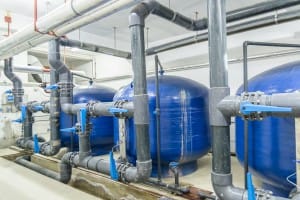Brain not brawn: applying intelligence to pumping operations
 Imagine having to collect water and carry it to your home. Hard work? Indeed! To move water requires energy – be it human effort or electricity. Pumping accounts for a large proportion of a water utility’s energy usage, and it comes at significant cost. As cities begin to incorporate new water sources (stormwater, recycled water, groundwater), treatment and distribution grow increasingly complex – and so does the pumping operation. Optimisation is therefore crucial for sustainable water distribution.
Imagine having to collect water and carry it to your home. Hard work? Indeed! To move water requires energy – be it human effort or electricity. Pumping accounts for a large proportion of a water utility’s energy usage, and it comes at significant cost. As cities begin to incorporate new water sources (stormwater, recycled water, groundwater), treatment and distribution grow increasingly complex – and so does the pumping operation. Optimisation is therefore crucial for sustainable water distribution.
Traditional vs alternative water sources
While much has been done to maximise the pumping efficiency of traditional systems based on potable water, little research exists for alternatives such as harvested stormwater. And the increased complexity of alternative-source systems makes optimisation a much bigger challenge.
Adelaide University PhD student Lisa Blinco is addressing that challenge by building intelligence into pumping operations. Her research – developing a methodology to optimise integrated pumping from alternative water supplies – is a component of Intelligent urban water systems (Project C5.1) at the CRC for Water Sensitive Cities (CRCWSC).
Angus Creek stormwater harvesting scheme
Lisa is working with several case studies to develop her methodology. Craig Bush, Catchment Management Officer at Blacktown City Council in western Sydney, invited Lisa to assist with the new Angus Creek stormwater harvesting scheme, following her presentation at the 2014 Water Sensitive Cities conference.
The highly urbanised Angus Creek catchment generates on average two billion litres of stormwater annually, of which 200 megalitres will be harvested to irrigate reserves and sports fields (including a high-profile Australian Football League (AFL) and cricket oval), as well as flush public toilets and top up ornamental lakes. Maintaining the expensive AFL ground is a priority for the council, and the scheme is expected to safeguard irrigation capacity during water restriction periods. Council also anticipates saving 20% (around $80,000) on water bills annually.
 The Angus Creek scheme involves four pump stations, two of which contain variable-speed drives – so for example the rate at which water is pumped out of the creek can be adjusted according to the flow. This enables the system to maximise stormwater harvesting without compromising environmental flow. After collection, the water is pumped through a trash screen and flows into existing storage ponds. It is then pumped into a treatment wetland system, and sent through a mechanical treatment plant to a storage tank. From there it is pumped to seven irrigation tanks distributed throughout the reserves, ready for use.
The Angus Creek scheme involves four pump stations, two of which contain variable-speed drives – so for example the rate at which water is pumped out of the creek can be adjusted according to the flow. This enables the system to maximise stormwater harvesting without compromising environmental flow. After collection, the water is pumped through a trash screen and flows into existing storage ponds. It is then pumped into a treatment wetland system, and sent through a mechanical treatment plant to a storage tank. From there it is pumped to seven irrigation tanks distributed throughout the reserves, ready for use.
The scheme represents new territory for the council, and Craig is keen to work with Lisa to drive it efficiently. “We don’t have much experience with variable-speed drives and a system of this size,” he says. “We hope that Lisa and her team will be able to help us work out how to minimise our costs – both through efficient power use and also by operating the pumps in a way that ensures their longevity and minimises maintenance costs.”
Working smarter, not harder
A standard strategy for cost efficiency in traditional systems is to capitalise on off-peak electricity. Pumps are triggered on and off by the onset of the off-peak periods, and by the receiving tank’s water level. While the Angus Creek scheme will use this strategy for distribution, timing at the input end can’t be controlled: stormwater harvesting needs to occur during rain events, regardless of electricity pricing.
Being a smart system – with computer-embedded pumps, and monitoring devices in the creek and tanks – the Angus Creek scheme will self-regulate. It will need minimal human input once it is set up, saving on operational costs. It will collect and react to data on creek flow rate, water levels in respective storage bodies, and pumping rates. These data will also allow operators to tweak the system remotely, in real time.
Ultimately, Craig envisions the scheme optimising energy usage, minimising the need for maintenance, and exploiting harvested water without overflow at storage sites.
Intelligent design
So how do you work out the optimal pumping solution, to minimise costs and maintain equipment? Lisa’s methodology involves genetic algorithms, which are problem-solving procedures developed using the principles of natural selection: survival of the fittest, reproduction, and mutation. Through the natural selection process, the algorithm evolves to find the “fittest” solution to the problem being put to it (for example, using least power; or switching pumps on and off the minimum number of times).
Genetic algorithms have been used extensively and effectively with water distribution systems. Their advantage, explains Lisa, is that they can easily find optimal solutions for large and complex problems. Because they converge steadily on that solution as they evolve, they find it without having to go through every possible option. What’s more, their adaptability means they can be applied to any optimisation problem you want to solve.
Simulating the scheme
Before the algorithm can be run however, the entire scheme must be simulated using the modelling program EPAnet. Another advantage of Blacktown’s smart setup is that the data it collects can be compared with the expected figures from EPAnet and used to check the accuracy of the model.
A challenge lies in simulating an alternative-source system using software designed for traditional water sources. “We take it for granted when we model traditional systems that there’s water available in a reservoir, for example,” explains Lisa; “whereas with a harvested stormwater system, you may not always have water available in your wetland. It’s highly dependent on recent rainfall. You also need to take into account the time needed for treatment; water may not be immediately available when it first comes into the wetland.” Lisa may have to adapt the model to simulate the alternative-source system accurately.
Next steps
While Blacktown City Council will benefit from Lisa’s optimisation work, the stormwater harvesting scheme is relatively straightforward and therefore ideal for developing her methodology. Lisa will work with more complex schemes next – including the Orange water supply scheme in NSW, which incorporates surface water, groundwater, imported water, and harvested stormwater. Ultimately, Lisa aims to develop an effective industry tool for multi-objective optimisation of systems that integrate multiple water sources. As our cities inevitably move toward such integrated supplies, this will be crucial for utilities as they strive to contain the energy use and costs associated with water treatment and distribution.
Nicola Dunnicliff-Wells for the Mind Your Way team